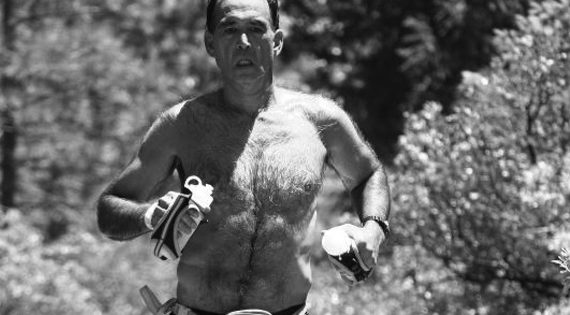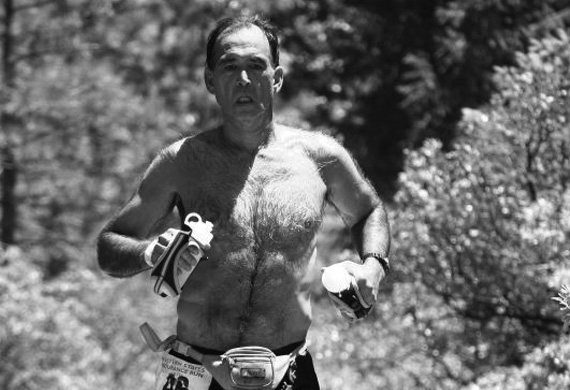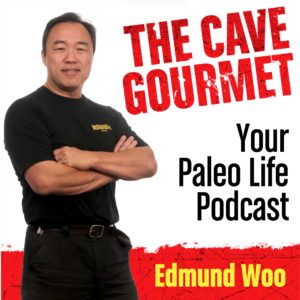Peter is a nutritional expert and ultra athlete who developed a safe and healthy approach to fat adaptation for endurance athletes called Optimized Fat Metabolism (OFM). After getting into running around 2000, Peter went from being a carb burner with poor results to a fat burner with success in racing. He specializes in using fat as fuel.
1:30
How did you get into all of this? How can your advanced knowledge apply to our audience?
It’s important to know that the concept of OFM is all about getting our bodies back to burning fat as our aerobic fuel source. The relevance to the paleo approach is that I look towards the science of anthropology and the evolutionary pressures that shaped human beings over time. We were very robust and active and really big fat burners.
5:30
So eating meat and fat gave us big brains, which we used to develop agriculture and grains.
We got a little too smart for ourselves, developed cooking and became hunter gatherers, then developed agriculture and science, then vitamins and supplements in the 1930s, ultimately arriving at processed man-made foods, not realizing the trade-off for convenience is our health. It’s impossible to return to our original state but getting back to that robust health and fitness of our ancestors is the goal.
8:45
How do you do that with your parameters?
We’re all about metabolizing fat, but with all these fad diets people forget you have to get your body physiologically to where it can burn the fat. There’s an infinite amount of variables besides genetics—environment, stress, etc. So if a person is overweight you want to look at why they’re overweight. Men are physiologically simpler than women, and with women, it’s not just the physiology, it’s the brain hardwiring.
11:25
Why is it more difficult for women to lose weight than men?
It’s very complex. The female mammal model in nature is ultimately designed to mature, cycle, and reproduce, and probably be a little overweight. It’s hormonally primed to be eating and saving for two, so it makes weight loss a lot more difficult. In a way, a woman has to be able to address this subconscious signaling and say, “It’s ok to let go of this extra fat.”
16:30
The trend of high-carb high-quantity meals or snacking during day is wrong. Womens’ leptin levels especially are already higher and snacking or carbs can affect this. It’s the feast or famine concept. Our ancestors used to get to snack only a few times per year, depending on when berries were ripe, for example. We can handle carbs but we’re not meant to do it 3-5 times a day for decades.
22:00
It depends on the individual to determine how many carbs one truly needs within a day or a week. Part of the problem is a cultural one too because we view drugs as bad and addictive but not carbs. They are physiologically, emotionally and mentally addictive and they create huge swings. When your blood sugar goes up and down it triggers you to think, “I gotta eat now.”
26:00
For someone who’s obese or metabolically challenged, cutting carbs the first week is probably going to leave them couched. When you’re taking away the energy you’re used to and you can’t access the energy you want to get to, it’s very difficult. Finding someone’s carbohydrate tolerance is the key.
36:41
Protein uptake is optimized when combined with fats. If you have the right balance of protein with the fat it’s pretty hard to have excess protein. It’s when you take naked protein that’s going to give you an excess, which can turn into sugar or nitrogen and work your kidneys over from trying to break down those proteins.
41:00
Most people are vitamin D deficient. The medical range is below where it should be; above 70 and below 150 nanograms seems to be a really good sweet spot.
44:00
Another metabolic engine is liver, due to the Vitamin K, but most people in the U.S. don’t eat enough organ meat. I recommend ruminate, desiccated liver tablets, or patè, foie gras, Braunschweiger, liverwurst, or rich Wellington cheeses.
48:00
Most people are magnesium and zinc deficient. You have to get enough but not too much. Eating seafood regularly is the easiest way. I recommend taking magnesium chloride at the end of a meal, as well as taking epsom salt baths. This is very helpful for people who have a hard time sleeping.
52:00
People should be aware that for women, cravings for carbohydrates are much stronger during the mid-luteal phase of the menstrual cycle. Adding inflammation will increase irritability and menstrual symptoms, so reducing carbs and insulin load helps to keep the inflammation at bay.
54:00
How does hydration play into fat adaptation?
You have to drink more water, but that requires you to take in more salt. You’re going to need those saltier foods to help you lose fat; they’re not going to make you retain water at that point. If you get out of a chair or bend over and you get dizzy or sluggish, it’s usually low blood volume and you need to increase your water or salt intake. Drinking water with salty foods will help bring your blood volume up. When you’re fat adapted, everything changes; you need more salt when you’re fat adapted.
59:00
So what is Step 1 if you’re overweight?
Seek out good information so you can wrap your head around the concept and get your psychology right and become committed to this idea. Everyone’s different and you have to be willing to experiment and stick with it for the longterm (2 years). I’ve seen many people go from morbidly obese to being very physically fit.
1:01:00
Once you see the signs of fat adaptation—where you’re not hungry, the weight is starting to come off, you start to really get into an exercise pattern—that’s when your body says, “Maybe I should conserve some of that glycogen and burn the fat.”
Go to vespapower.com or fatadaptation.com or optimizedfatmetabolism.com to learn more or contact Peter Defty.
Podcast: Play in new window | Download



Recent Comments